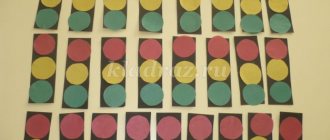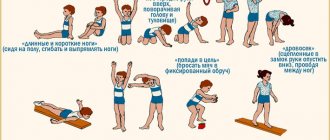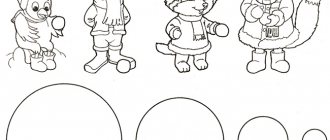What games help develop sensitivity at all levels?
Since I’m in the younger group, I’ll give you my card index, but I’ll try to make additions for different ages. In general, the meaning of such games is this: to give the child a wide range of sensations and knowledge about the properties of objects, substances, phenomena that can be felt tactilely, visually, auditorily and “smelling”. In the same way, these same sensory-didactic, that is, educational games are suitable for young children. It is necessary to select games that are adequate to the child’s age capabilities.
For simplicity, I divided the card index into 5 blocks: the development of visual perception, auditory, olfactory, tactile, as well as games for fine motor skills and purposeful actions.
I will not describe absolutely all the components of the card index, and it would be stupid to list them without a description, because you can’t always understand the essence by the name, so I will give a description of the most effective games for sensory development. You will see how simple, interesting and useful it is to amuse your baby and teach at the same time!
So, 1 block of didactic games for training visual sensitivity:
- “Lids and boxes”: you can take empty plastic jars with gouache lids, they are usually multi-colored. Place cards inside to match the color of the box. For older children, you can place beads or other small objects in monochrome colors.
Objectives: we train the ability to correlate colors, find identical ones, analyze and systematize. At the same time, we train motor skills, learning to open lids. We exercise the ability to distinguish shape and size. If you shake a jar with a card inside, you will also train your hearing.
Believe me, if you complicate the task, the middle and older groups will be interested in this game. For them, you can add shades of colors, place inside a card with a picture that is not monochrome, but made predominantly of one color. We select lids with threads to make it more difficult to open.
- “Vegetable Garden” is a game for the development of sensory standards. We take small square cardboards, draw the outline of a fruit or vegetable on them and cut out the middle. Separately, we have cardboard boxes of the same size, but completely painted over, matched to the colors of the prepared fruits and vegetables. Task: find its color for each fruit and place the blank on top of the corresponding colored cardboard.
Didactic games for the development of auditory perception: 2nd block
- To organize this type of game, waste material is suitable. For example: “Colorful noisemakers.” We take plastic bottles and glue labels of different colors to them, but of the same color. We will stir anything inside, as long as it fits into the neck and is matched to the color of the label: dyed legumes, cereals, beads, sand. The baby shakes these noisemakers, now stronger, now weaker, catching the difference in the sounds made.
At the same time, we will train our visual perception of color and motor skills. Children aged 2-3 years love this game. In the second junior group, and even in the first junior group, this fun is a great success. Apparently, babies still miss rattles...
And to make the fun more interesting in the 1st junior group, you can decorate the noisemakers in the form of toys: take a plastic Kinder egg, put different objects inside (cereals, a ball, whatever), cover them with fabric or crochet them, creating chickens, for example. Each chick will make different noises.
The preparatory group can complicate the task: pour the contents of the bottles into separate boxes and then again select the filling required for each specific bottle by color. In addition, if you shake bottles consciously, you develop a sense of rhythm, and this is an ear for music!
- "Who's making noise?" – goes well in the middle group. Behind the child’s back, we make characteristic sounds using any objects: rustling the pages of a book, knocking something on the table, etc. The child must guess what makes the sounds. Great ear training!
Block 3: developing the sense of smell...
There is no need to go far here; the games smoothly move into the kitchen. The average group can cope with this task quite well:
- “Guess what the chick will eat?” – the child plays the role of a hungry chick, and someone else imagines himself as a mother bird who has flown in to feed her young. But the mother is cunning: the chick must first guess by the smell what the mother brought him. We bring the child a piece of something edible and let him inhale the aroma. This is very interesting for older children, but the 2nd younger group can also try to guess.
- Older preschoolers will enjoy competing in the game “What does it smell like?” The idea is this: we make small bags of gauze in advance, and immediately before the game we place pieces of food with a characteristic aroma into the bags: citrus fruits, coffee beans, onions, garlic, apples, etc. Again, the baby guesses what’s inside.
Now the expanse of fruits, the preparatory group and younger preschoolers can train a more subtle sense of smell, let them learn to distinguish the smells of vegetables and fruits with a weakly expressed aroma.
Despite the simplicity of such didactic games, they are of great benefit. Through play, the child receives full sensory education and enriches the world of his sensations. And this already develops the brain as a whole. Moreover, our vocabulary is also enriched, because we learn new words.
4th block: enriching tactile sensations
- “Surprise”: place a deep container with sand, cereals, etc., in which objects are hidden. The child finds it, rejoices and at the same time develops the sensitivity of his fingers.
- “Hello!”: we make blanks in advance from materials of different textures, gluing them onto cardboard and cutting out palms. The child puts his palm on the workpiece, feels the texture, learns new concepts: smooth, rough, soft, fluffy.
- “Sinking or not sinking”: we take a container with water and in another container - different objects that can be soaked in water. The child explores which objects sink and which do not, and tries to guess in advance the possibility of floating on the water.
To develop tactile sensations, you can use everything you see around the house while walking. Yes, the child trains himself, feeling everything that comes to hand. But it is imperative to focus the baby’s attention on the names of phenomena and sensations. Pay attention to color, shape, size.
What can I say, you have already guessed how useful didactic games for the development of tactile sensations are for little autistic children - autistics, and for all children with mental retardation (mental retardation).
Block No. 5: learning to take purposeful actions
- “We sell cereals”: we pour different types of cereals or sand into bowls, we learn to pour cereals into other containers, as if for a buyer.
- “Treat the doll with candy”: take round plastic round containers with lids and decorate them in the shape of a doll’s head. Glue or draw a face and hair. We cut a small hole in place of the mouth. Separately, we are preparing a box with multi-colored buttons, which will be our candies. You need to push the candy button into the doll’s mouth.
- Exercise machines with laces, Velcro buttons, clasps, etc. work great for educational purposes. At least you need to make a simulator with buttons: sew buttons onto the fabric, stretch the fabric onto plywood or something similar. Separately, we make blanks with loops for buttons, for example, these are flower petals that need to be attached to a button and made into a flower.
Even the descriptions of several games took up a lot of space on the blog page. I suggest just buying special literature and making your own card index of didactic games.
So, manuals from UchMag:
- “Sensory development of young children. 1-3 years." While the book is out of stock, you can always leave a request for a missing item on this website;
- “Sensory development of children 2-3 years old. Color. Form. Size” – here are presented didactic games and exercises for organizing joint activities between the teacher and young children;
- “Sensory development of children 3-4 years old. Color. Form. Size" - the same for younger preschool age;
- “Sensory development of children 4-5 years old. Color. Form. Size” – respectively, average preschool age;
- “Sensory development of children 5-6 years old. Color. Form. Size” – materials for the older group;
- “Sensory development of children 6-7 years old. Color. Form. Size" - for the preparatory group.
The task of games-activities for the sensory development of children
The main task of games and activities for children is to accumulate a variety of sensory experiences, which would help to systematically accumulate knowledge, gain new ones, and apply them in different situations at the next stages of learning and fine art and design.
— What games do you use at home for sensory development?
— How do you play with your children?
— What do these games teach a child?
It is important that educators, when organizing games and activities, use brief verbal instructions and do not distract children from completing tasks with words.
But many studies in the field of correctional pedagogy show that children often have underdeveloped perception: it is fragmented, inaccurate and unfocused. Preschoolers have insufficiently developed sensory standards.
Therefore, there is a need to create conditions that would allow the exercise of sensory functions during systematic training. Children train to distinguish and classify signs of the world around them in order to more accurately and adequately interact with it.
Methodology for organizing didactic games for sensory development
Let's consider the methodology for organizing didactic games for children of primary preschool age.
- In younger preschoolers, excitation processes prevail over inhibition processes. Visuals are more effective for them than words. Therefore, it is advisable to explain to them the rules and demonstrate the game action itself. If a game has different rules, don't tell them all at once.
- Games should be conducted in such a way that they allow children to experience joy and cheerfulness.
- We need to teach children to play in such a way that they do not interfere with each other, gradually learn to unite to play in small groups and realize that playing together is much more interesting.
- A teacher with younger preschoolers should try to get involved in the gameplay themselves. First you need to attract children to play with didactic materials. Then you need to take them apart and put them back together with the guys. It is necessary to awaken children's interest in didactic materials and teach them to play with them.
- At this age, children have a predominant sensory perception of the surrounding reality. Taking this into account, the teacher tries to select material that can be explored and actively acted upon.
- Games familiar to children will become even more exciting if something complex and new is introduced into their content, which requires activation of mental processes. Therefore, you need to repeat the game in different variations, gradually complicating their rules.
- When the rules of the game are explained, the teacher should turn his attention to the different players so that everyone thinks that they are telling him about the game personally.
- In order for the game to become more successful, the teacher must prepare the children for the game process: before the game, children must become familiar with the objects that will be used, with the images and their properties.
- After the game, the teacher must definitely notice the positive aspects: praise the children for what they did.
- Interest in games will increase if the teacher invites them to play with the toys that were used during the game.







